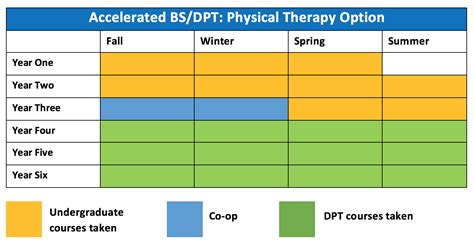Introduction

Drexel University’s Doctor of Physical Therapy (DPT) program is renowned for its rigorous academic curriculum, cutting-edge research, and exceptional clinical training. As a leading institution in the field of physical therapy, Drexel prepares its graduates to excel in the ever-evolving healthcare landscape.
The three-year DPT program at Drexel University encompasses:
- Didactic coursework: In-depth instruction in anatomy, physiology, biomechanics, neuroscience, and other fundamental principles of physical therapy.
- Clinical internships: Supervised hands-on experience in various healthcare settings, including hospitals, outpatient clinics, and rehabilitation centers.
- Research opportunities: Students participate in research projects under the guidance of renowned faculty to enhance their critical thinking and inquiry skills.
Curriculum Highlights
The DPT curriculum at Drexel University is designed to equip students with the knowledge, skills, and values necessary to provide comprehensive patient care. Key highlights include:
- Evidence-Based Practice: Emphasis on integrating research findings into clinical decision-making to ensure optimal patient outcomes.
- Interprofessional Collaboration: Opportunities to interact and collaborate with students from other healthcare disciplines, fostering a team-based approach to patient care.
- Patient-Centered Approach: Focus on understanding the unique needs of each patient and developing individualized treatment plans.
Clinical Training
Drexel University’s DPT program provides exceptional clinical training experiences in a wide range of settings. Students gain hands-on experience in:
- Acute Care: Trauma centers, intensive care units, and burn units.
- Rehabilitation: Inpatient and outpatient rehabilitation facilities.
- Outpatient Clinics: Private practices and community health centers.
- Neuromusculoskeletal: Orthopedic clinics, spine centers, and sports medicine facilities.
Research and Innovation
Drexel University is home to the renowned Center for Functional and Restorative Movement (CFRM). Faculty and students collaborate on cutting-edge research in areas such as:
- Biomechanics: Using advanced motion analysis techniques to improve patient mobility.
- Neuroscience: Investigating the neural mechanisms underlying movement and recovery.
- Patient-Reported Outcomes: Developing tools to measure and improve patient experiences.
Outcomes and Career Prospects
According to the American Physical Therapy Association (APTA), the job outlook for physical therapists is “excellent” with a projected growth rate of 27% from 2016 to 2026. Drexel University’s DPT graduates are highly successful in the field and have gone on to become leaders in clinical practice, research, and academia.
Effective Strategies for Success
To achieve success in Drexel University’s DPT program, students should employ effective strategies such as:
- Active Learning: Engage fully in lectures, participate in discussions, and seek additional resources to enhance understanding.
- Time Management: Create a structured schedule to balance academic responsibilities with clinical training and extracurricular activities.
- Collaboration: Form study groups, ask for assistance from professors and teaching assistants, and seek support from peers.
Common Mistakes to Avoid
To maximize their potential in the DPT program, students should avoid:
- Procrastination: Delays in completing assignments and preparing for exams can lead to unnecessary stress and diminished performance.
- Isolation: Avoiding interaction with professors, classmates, and clinical preceptors can hinder learning opportunities.
- Overwork: While hard work is essential, it is crucial to maintain a work-life balance to prevent burnout and ensure well-being.
Pros and Cons of Drexel University’s DPT Program
Like any academic program, Drexel University’s DPT program has its advantages and disadvantages:
Pros:
- Rigorous Curriculum: Prepares graduates for a wide range of clinical practice settings.
- Exceptional Clinical Training: Supervised experiences in diverse healthcare environments.
- Research Opportunities: Fosters critical thinking and inquiry skills.
- Reputation for Excellence: National recognition and respect in the field.
Cons:
- Competitive Admissions: Acceptance rates are typically low, requiring strong academic credentials.
- Demanding Program: The fast-paced curriculum and intensive clinical rotations require dedication and resilience.
- High Cost: Tuition fees can be a financial burden for some students.
Conclusion
Drexel University’s Doctor of Physical Therapy program provides an exceptional foundation for a successful career in physical therapy. Through its rigorous curriculum, cutting-edge research, and exceptional clinical training, Drexel graduates are equipped with the knowledge, skills, and values to make a meaningful difference in the lives of patients.
Application Deadlines:
- Early Decision (Optional): November 1st
- Priority Application: February 1st
- Regular Decision: May 1st
Tuition and Fees:
- In-State Students: $49,000 per year
- Out-of-State Students: $62,000 per year
Class Profile:
- Average GPA: 3.8
- Average GRE Score: 159 Verbal, 158 Quantitative, 4.4 Writing
Contact Information:
Drexel University
Department of Physical Therapy
3141 Chestnut Street
Philadelphia, PA 19104
Phone: (215) 895-2737
Email: [email protected]
Table 1: Projected Job Growth for Physical Therapists
| Year | Job Growth Rate |
|---|---|
| 2016-2026 | 27% |
Source: American Physical Therapy Association
Table 2: Drexel University DPT Program Costs
| Item | Cost |
|---|---|
| Tuition (In-State) | $49,000 per year |
| Tuition (Out-of-State) | $62,000 per year |
| Fees | $3,000 per year |
Source: Drexel University
Table 3: Clinical Training Sites
| Setting | Examples |
|---|---|
| Acute Care | Jefferson Hospital, Temple University Hospital |
| Rehabilitation | Magee Rehabilitation Hospital, Bryn Mawr Rehab |
| Outpatient Clinics | Athletico, PT Solutions |
| Neuromusculoskeletal | Rothman Orthopaedic Institute, Penn Medicine |
Source: Drexel University
Table 4: Pros and Cons of Drexel University’s DPT Program
| Pros | Cons |
|---|---|
| Rigorous curriculum | Competitive admissions |
| Exceptional clinical training | Demanding program |
| Research opportunities | High cost |
| Reputation for excellence |
